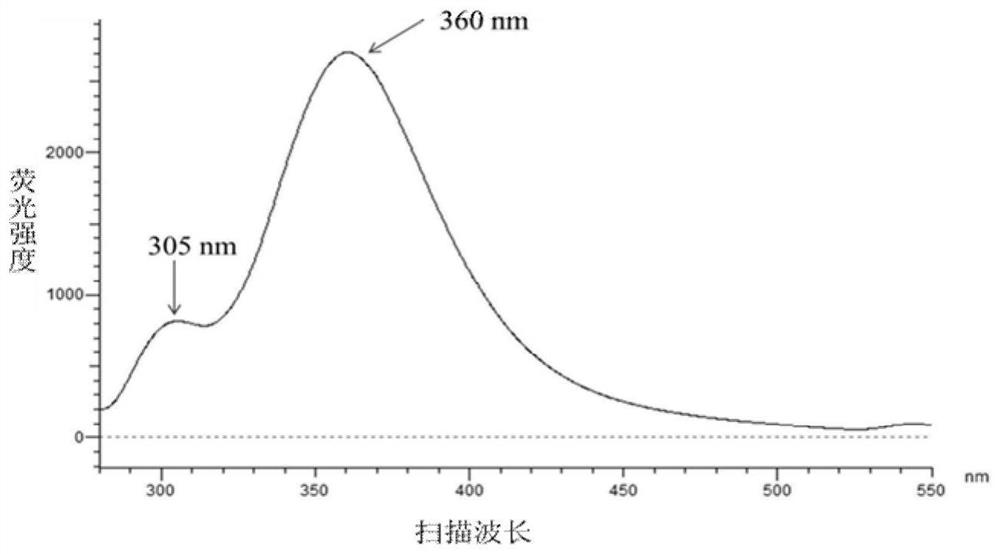Method for quickly determining nature of manuka honey
A manuka honey, rapid technology, applied in the detection of manuka honey, the detection field, can solve the problems of dependence, inability to realize on-site, rapid detection, different levels, etc.
- Summary
- Abstract
- Description
- Claims
- Application Information
AI Technical Summary
Problems solved by technology
Method used
Image
Examples
Embodiment 1
[0023] Sample pretreatment:
[0024] Accurately weigh 1.000g of the sample, place it in a 50mL polytetrafluoroethylene centrifuge tube with a cover, dilute with high-purity water to 50mL, vortex and oscillate to mix, take about 5mL of the supernatant, and pass through a 0.45μm nylon microporous filter membrane. Waiting for instrument detection.
[0025] Instrument measurement conditions:
[0026] Excitation wavelength: 270nm; Excitation slit: 10nm; Emission slit: 10nm; Emission spectrum scanning range: 280nm~550nm; Scanning speed: 1200nm / min.
[0027] Such as figure 1 As shown in , Manuka monofloral honey has a fluorescence peak at 305nm and 360nm respectively, but the intensity of the characteristic fluorescence peak at 360nm is more than twice the intensity of the fluorescence peak at 305nm; as figure 2 The Manuka multifloral honey shown in has an obvious fluorescence peak at 305nm and 360nm respectively, and the difference in fluorescence intensity between the two is no...
Embodiment 2
[0029] According to the method in Example 1, a total of 14 manuka, kanuka, clover, Christmas flower, rivarewa, manna, etc. from different origins in New Zealand were collected from the hive by using the molecular fluorescence spectroscopic analysis method. The mature raw honey samples were tested.
[0030] A total of 13 samples of 6 different varieties, including manuka, kanuka, clover, Christmas flower, rivarewa, and honeydew honey, were numbered and the corresponding honey types were recorded.
[0031] Then according to the method in embodiment 1, use molecular fluorescence spectrum analysis method to detect above-mentioned 13 samples, and test result is compared with known and recorded honey kind, detection and comparison result are as shown in table 1,
[0032] Table 1:
[0033]
[0034]
[0035] The results in Table 1 show that the results of the detection method disclosed by us are consistent with the actual samples, indicating that the detection method disclosed ...
Embodiment 3
[0037] 42 commercial honey samples from New Zealand and Australia were detected according to the molecular fluorescence spectrum analysis method disclosed in the present invention (Example 1) and the pollen DNA detection method officially released by the New Zealand Ministry of Primary Industries, and the detection results are shown in Table 2 ;
[0038] Table 2:
[0039]
[0040]
[0041] According to Table 2, it can be seen that among the 20 commercial honeys marked as Manuka from New Zealand, 18 samples are Manuka honey and monofloral Manuka honey, and 2 samples are non-Manuka honey; Of the 2 commercial honeys from New Zealand marked as Manuka blend honey, 1 sample was multiflora manuka honey and the other was non-manuka honey; 2 commercial honeys from Australia marked as Manuka Among the commercialized honeys, one sample is Manuka honey, and it is monofloral Manuka honey, and the other is non-Manuka honey; a total of 18 commercial honeys from New Zealand and Austral...
PUM
 Login to View More
Login to View More Abstract
Description
Claims
Application Information
 Login to View More
Login to View More - R&D
- Intellectual Property
- Life Sciences
- Materials
- Tech Scout
- Unparalleled Data Quality
- Higher Quality Content
- 60% Fewer Hallucinations
Browse by: Latest US Patents, China's latest patents, Technical Efficacy Thesaurus, Application Domain, Technology Topic, Popular Technical Reports.
© 2025 PatSnap. All rights reserved.Legal|Privacy policy|Modern Slavery Act Transparency Statement|Sitemap|About US| Contact US: help@patsnap.com



